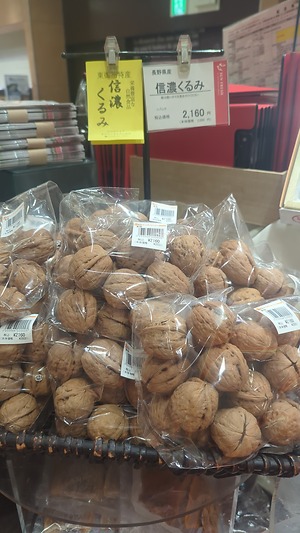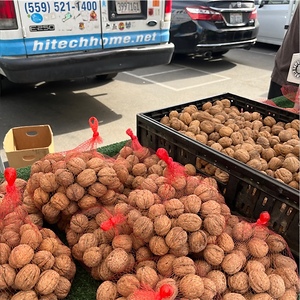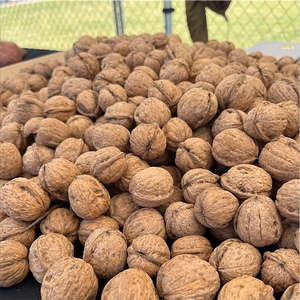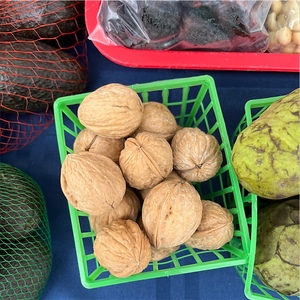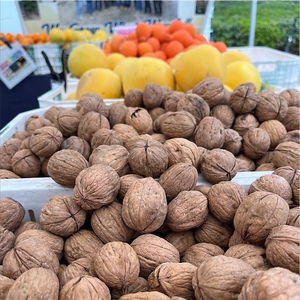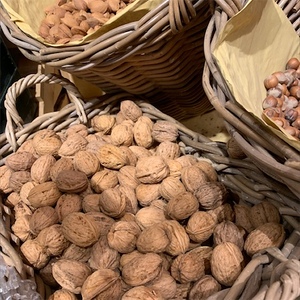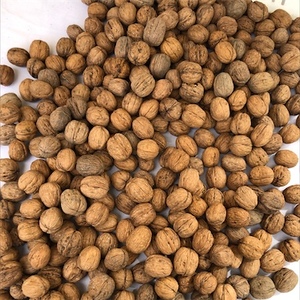


Whole Walnuts in the Shell
Estimated Inventory, 50 lbs : 0
Description/Taste
In-shell Walnuts are ovate and consistently sized with a three-centimeter diameter. The shell of the Walnut is hard and furrowed, with deep ridges covering the entirety of the surface and a seam extending through the middle. Once split, the shell reveals two nut halves with symmetrical segments, large bumps, and long, deep ridges, creating a winged, butterfly shape. They are light brown in color and covered in dark brown veins spreading outward from the center of the nut on both sides. Walnuts have a semi-soft and smooth interior with a pleasant crunch. The nuts have a distinctive earthy, piney, and citrusy aroma and a rich, sweet, and earthy flavor with a slight bitterness.
Seasons/Availability
Walnuts are available year-round, with fresh Walnuts harvested from late August through late November.
Current Facts
Walnuts are the edible, ridged seed of the Walnut tree, a deciduous tree botanically classified as Juglans regia. The nuts are held within a bright green fruit with a leathery or woody texture. When the nuts are ready to be harvested, the hull splits open, revealing the brown, deeply ridged, oval walnut shell. In-shell Walnuts must be cracked open with a nutcracker to release the meat inside. There are approximately 20 different species of walnut trees, but the most commercially produced variety is the English Walnut. This variety results from selective breeding, resulting in a cultivar with a softer shell that ripens more quickly and is disease resistant. English Walnut trees also produce their first crop quicker than other varieties and have a life expectancy of 60 to 100 years, although some can live up to 300 years. In order to maintain the variety, English Walnut trees need to be propagated using the layering technique. Trees that are grown from seed can revert to characteristics from past parent cultivars. The fruits of the trees grow in groups of 2 to 3 and ripen at the end of summer. Walnuts are not only harvested for their nut. They can be pressed for walnut oil, which is used extensively in cooking and oil paint, the husks can be used to make dye, and their wood is highly prized for its color, hardness, and beautiful grain.
Nutritional Value
Walnuts are an excellent source of omega-3 fatty acids, specifically alpha-linolenic acid, an acid known to boost memory, concentration, and cognitive function to protect against cardiovascular disease. The nuts are also a rich source of vitamins and minerals known to support the brain and the immune system, including vitamin E, copper, selenium, iron, and niacin.
Applications
Walnut shells must be removed before they can be used. This can be done with a nutcracker or in a bag with a pan. After the shell has been cracked, the meat should be sorted out, and the shell should be discarded. Walnut halves and pieces can be enjoyed raw, toasted, or candied as a snack, or they can be added to a variety of recipes. The nuts are commonly used in baking, where they are added to brownies, cookies, muffins, scones, and a variety of quick and yeast bread, including banana bread, cinnamon rolls, and cranberry walnut bread. The nuts can be added to salads like chicken salad, Waldorf salad, or a roasted vegetable and kale salad featuring feta cheese and squash. Walnuts can be ground into flour, nut butter, or blended into nut milk that can then be used in baking or cream-based sauces, custards, and ice cream. Walnuts pair well with a variety of fruits, including nectarines, apricots, dates, apples, pears, and bananas, as well as warm spices like cinnamon and nutmeg. The nuts can be added to roasted root vegetables like carrots and beets, sprinkled over sauteed green beans, and served beside soft and salty cheeses on a cheeseboard. In-shell Walnuts should be stored in a cool and dry place and used within three months for quality and freshness.
Ethnic/Cultural Info
Walnuts are highly prized in Chinese culture but not as food. In the second century, the nuts were introduced to China and quickly became a popular toy in Chinese Imperial courts. Pairs of shelled Walnuts were rotated together in the palm of the hand to stimulate blood circulation. This pastime became even more popular during the Qing dynasty, elevating the nuts to a status symbol coveted by the country’s elite. Growers and collectors searched for pairs of Walnuts with similar sizes, shapes, and grooves along the shell to make rolling smoother. The more closely the pair-matched, the more expensive it became. With the modern-day economic growth in the country, demand for matching Walnut pairs has skyrocketed along with the price people are willing to pay. This demand has transformed the livelihoods of Walnut farmers in Laishui county, located just a few hours from Beijing, where one farmer sold a prized pair of Walnuts for 160,000 yuan and averages close to 2 million yuan a year from his harvest. The area hosts Walnut festivals, and people come from all over China to try and find a matching pair of Walnuts in the open-air market. Some even participate in a game that is like gambling where pairs of un-hulled walnut fruits are purchased, hoping the nuts inside are worth more than they pay.
Geography/History
Walnuts were first found in Persia and are native to a broad region across Asia, stretching from the Balkans to China, and have been eaten in the area for over 8,000 years. The nuts were highly prized in Ancient Greece and Rome and have been enjoyed in China since 200 BCE. The nuts were spread throughout Europe by the Roman Empire during Charlemagne’s rule and along trade routes through Asia and the Middle East. By the Middle Ages, Walnuts were cultivated as far north as England. The English are credited with spreading the nuts to other parts of the world, including North and South America, which is how the nuts came to be known as English Walnuts. Walnuts flourished in the Mediterranean-like climate of California, and by the 1870s, commercial production in California began. Today, the world’s leading producers of Walnuts are China, the United States, Iran, and Turkey. Walnuts can be found in grocery stores, distributors, farm stands, and natural food stores in North America, Europe, and China.



